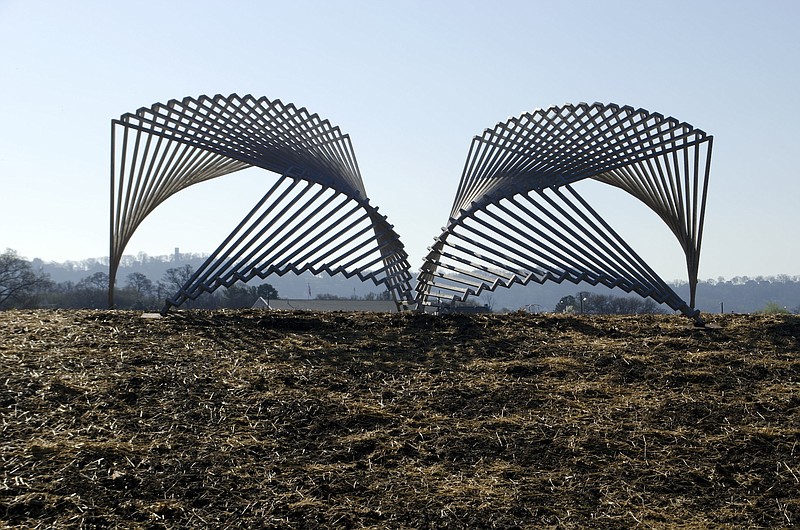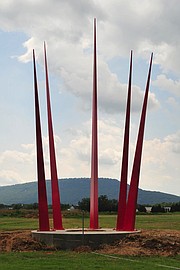If you go
What: Sculpture Fields at Montague Park grand openingWhere: 1800 Polk St.When: 6-10 p.m. Friday, 8 a.m.-5 p.m. SaturdayAdmission: FreeFor more information: 423-266-7288
Schedule
Friday› 6 p.m. — Welcoming remarks by Tony Jones› 8:30 p.m. — Cross Pollination iron pour and danceSaturday› 8 a.m. — Yoga class, tai chi demonstration and walking meditation› 9:30 a.m. — Meet the Artists walk, 15 artists stationed at their sculptures to answer questions› 11 a.m. — Artist talk by sculptor Carl Billingsley› Noon — Jazz music by Charlie the Head› 2 p.m. — Artist talk by sculptor Terry Karpowicz› 2:30 p.m — Meet the Artists walk› 3-5 p.m. — Music by Rory Carroll. Food and beverage trucks onsite both days.
A one-of-a-kind performance Friday night in the Sculpture Fields at Montague Park will unleash red-hot, molten-iron bees to dance across the grounds of the East Chattanooga park, an event that hopes to set the local arts community abuzz with a visual and performing arts collaboration.
"Cross Pollination" will highlight opening night of a two-day celebration Friday and Saturday to mark the grand opening of the 33-acre Sculpture Fields. Twenty-seven large-scale sculptures are currently positioned in the park, which was founded by sculptor John Henry. The project has been in the works for several years, but officially broke ground in November 2014.
"What we are doing is building and developing the park in three phases," says Catherine Clifford, executive director of Sculpture Fields. "When we open April 8, that's the completion of Phase 1. Our goal was to have 25 sculptures in the park at this point, and we have 27. We have raised $1.2 million to complete the Phase 1 goal."
Clifford says work will start immediately on Phase 2, which will be the development of a visitors center at an estimated $3 million and the addition of 25 more pieces of sculpture. The third and final phase calls for acquiring 25 pieces of sculpture and the creation of an amphitheater.
The sculpture park sits on land that was once the Montague Park softball recreation complex, but it was closed in 2003 when state regulators found methane leaks in the ballfield; the park lies on the site of a former city landfill.
In 2008, city and state officials reached an agreement on how to return the park to a usable state, and the city followed the Tennessee Department of Energy and Conservation plan to replace a 3-foot cap of dirt and grass across the methane-affected area. Once approved by TDEC, work began to create the Sculpture Fields. The first sculpture, by Mark DiSuvero of New York City, arrived in 2013.
Clifford says the park has four connecting pathways that form a mile-long walking trail among the artwork. Through a partnership with Chattanooga's Sister City Association, work has begun on a commemorative forest. Since January of this year, 87 trees have been planted on the property, 72 of them through a grant from the Riverview Foundation. Clifford says long-range plans are in place to develop the park into an arboretum.
The grand opening will kick off Friday night at 6 p.m. with remarks by Tony Jones, president of the Kansas City Arts Institute.
"Tony Jones is one of the foremost experts on the economic impact of sculpture parks. He was involved in the development of Chicago's Millennium Park," Clifford says. "He says that the economic impact of Millennium on Chicago in the first 10 years was $1.9 billion. That's the story he'll be telling - the impact sculpture fields can have on the economy in their communities,"
As soon as dusk falls, artist Allen Peterson will prepare the iron-pour performance, assisted by Isaac Duncan and a crew of dancers from Atlanta and Chattanooga. Clifford says 500 pounds of iron have been donated by Eureka Foundry for the event. Work will actually begin Friday afternoon when the iron is melted for use in "Cross Pollination."
Peterson says a cupola-style furnace will produce the molten iron, which will be decanted into molds that form glowing, bird-sized bee forms. Using cold-steel handles, the bees will be released from the molds while they are still glowing from the heat of the casting. The bees are then passed to dancers who will "fly" the bees through the night by holding the long steel handles.
"The dancers pilot the bees in a choreography that is based on the language of dance that actual honeybees use inside their hive," Peterson explains. "Many of the bees start their dance by seeking out the forest of sculptural flowers and 'pollinating' one of the blossoms."
The pollination will be depicted by the still-hot bee igniting a mini-torch within a flower form which blossoms into flame. After the bloom is pollinated, the bee is flown to an open area, where it will interact with other bees.
The furnace will continue to decant bees until 48 glowing shapes have been released. By the end of the fourth and last round of bees, all the mini-torches will be lit, illuminating the landscape and sculptures.
Clifford says that two dozen of the iron bees will be sold at the end of the evening for $50 apiece.
Contact Susan Pierce at spierce@timesfreepress.com or 423-757-6284.

